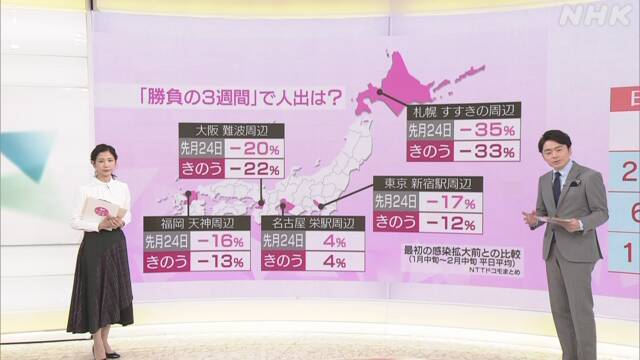As the government called for thorough infection control as a "three weeks of competition," the number of people in downtown areas of major cities on the 15th was from January to February, before the first spread of the infection. In comparison, Sapporo decreased by more than 30%, while Nagoya increased slightly.
NTT DoCoMo collects data on the number of people nationwide in a privacy-protected manner based on information on mobile phone base stations.
While the government has positioned it as a "three weeks of competition" and is calling for thorough measures against infection with the new coronavirus, the number of people at 3:00 pm on the 15th was before the first spread of the infection, from mid-January to February. Compared to the average on weekdays until the middle of the
week
,
▽ Sapporo / Susukino area is minus 33%
▽ Tokyo / Shinjuku station area is minus 12%
▽ Osaka / Namba area is minus 22%
▽ Fukuoka / Tenjin area is minus 13% On the other hand, the
area around Nagoya / Sakae Station increased by 4%.
Furthermore, if you go back to the period until the 24th of last month just before the "three weeks of the game" every other week,
▽ around Sapporo / Susukino is minus 35% to minus 37%
▽ around Tokyo / Shinjuku station is from minus 14% -17%
▽ Osaka / Namba area increased from -20% to -26%
▽ Fukuoka / Tenjin area increased from -14% to -16%
▽ Nagoya / Sakae station area increased from 2% to 4%.
Compared to the 15th, there is no noticeable big change and the decrease in Sapporo is large.

